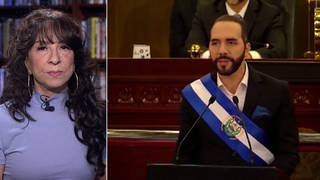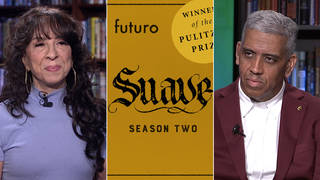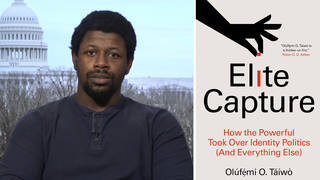
Guests
- Matthew Delmontassistant professor of American studies at Scripps College in California and author of the new book, The Nicest Kids in Town: American Bandstand, Rock 'n' Roll, and the Struggle for Civil Rights in 1950s Philadelphia.
Last month the pioneering TV broadcaster Don Cornelius died at the age of 75. As the host of “Soul Train,” many obituaries described Cornelius as the “African-American Dick Clark,” the legendary host of the popular TV show, “American Bandstand,” from 1956 to 1989. Clark claimed the show, which was originally hosted in West Philadelphia before moving to Hollywood, was “one of the first integrated shows on national television.” But a newly published book challenges this history and reveals new details about how the show discriminated against black youth during its early years. “This is a story about civil rights and about segregation in the North,” says Matthew Delmont, author of “The Nicest Kids in Town: American Bandstand, Rock 'n' Roll, and the Struggle for Civil Rights in 1950s Philadelphia.” “They didn’t have a formal policy that said 'no blacks allowed.' … They had a host of very underhanded techniques they would use to keep black teens off the show.” [includes rush transcript]
Transcript
JUAN GONZALEZ: Last month, the pioneering TV broadcaster Don Cornelius died at the age of 75. As the host of Soul Train, Cornelius helped bring the voice of African Americans into living rooms across the country. Many obituaries described Cornelius as the “African-American Dick Clark,” the legendary host of American Bandstand.
In 1956, Dick Clark began hosting a show called Bandstand in the Philadelphia region. Within a year, the show was renamed American Bandstand and began airing daily on national TV. It soon became one of the most popular and influential TV shows ever. The show introduced millions of young people to rock 'n' roll music and new dance moves.
That was the opening theme song to American Bandstand.
Dick Clark, who may be best known to younger audiences as the host of Dick Clark’s New Year’s Rockin’ Eve, began portraying American Bandstand in the 1970s as a pioneering program in part because it showed white and black youth in an integrated setting.
In 1978, Dick Clark wrote, quote, “The civil rights movement captured the conscience of America as the first wave of 'sit-ins' spread throughout the South while sympathetic boycotts were organized in the North. I’m proud to say 'Bandstand' was already by then one of the first integrated shows on national television.”
AMY GOODMAN: Dick Clark later said, quote, “In 1957, we were charting new territory. I don’t think of myself as a hero or a civil rights activist for integrating the show; it was simply the right thing to do.”
Well, a newly published book challenges this history of American Bandstand and reveals new details about how the show discriminated against black youth during its early years and how black teens and civil rights advocates protested the discrimination. The book is called Nicest Kids in Town: American Bandstand, Rock 'n' Roll, and the Struggle for Civil Rights in 1950s Philadelphia.
We’re joined by its author, Matthew Delmont, assistant professor of American studies at Scripps College in California.
Thanks so much for being with us, Professor Delmont. Well, what’s the real story?
MATTHEW DELMONT: The real story is that American Bandstand was a segregated program for the whole time it was in Philadelphia. It actually became segregated before Dick Clark took over the show. So, as a local program under the control of Bob Horn, it started in 1952. And they implemented these racial discriminatory policies in 1954 and 1955, because they were concerned about fights that were happening outside of the studio. And Bandstand didn’t want to bring any of that sort of potential teenage violence into the studio and upset advertisers or viewers. So, when Dick Clark took over the program in ’56, it was already segregated. And it remained a segregated program from ’57 until it left for Hollywood in 1964.
JUAN GONZALEZ: Well, Professor Delmont, in the book, you paint this picture—the studio for the show was in West Philadelphia—of black—of battles outside, because black youths were not admitted in, and also of the African-American leaders at the time, who attempted to raise the issue.
MATTHEW DELMONT: Yeah, one of the things that people don’t often realize about American Bandstand is it broadcast from a residential neighborhood in West Philadelphia, so it was right in the heart of one of the most vibrant and racially diverse communities in Philadelphia. So, the demographics of West Philadelphia at the time were heavily African American, but there were a number of Italian Americans, Jews, and it was a very racially diverse area. There are pictures from the West Philadelphia High School yearbook that demonstrate the racial demographics of the neighborhood, so it was extremely racially diverse.
You didn’t see any of that in Bandstand. Part of what was going on with Bandstand is they were concerned about representing the actual Philadelphia. They wanted to represent sort of a white version of Philadelphia, because they thought that would be most appealing to advertisers and to suburban viewers. But this became a point of controversy almost immediately for the African-American community. So, I found evidence of dozens of cases of African-American teenagers or their parents protesting the show, writing in to the African-American newspaper, the Philadelphia Tribune, to try to get people to take up this case, including many of the early civil rights activists in Philadelphia.
AMY GOODMAN: Professor Delmont, how would you explain the Bandstand policies? And then just take us through the change and the activism, the protest that we don’t know very much about today.
MATTHEW DELMONT: Sure. So, one of the interesting things about _Bandstand_’s policies is this is a story about civil rights and about segregation in the North. And what that means is they didn’t have a formal policy that said “no blacks allowed.” So this wasn’t like what you’d see in the South with de jure segregation, where you’d have a drinking—a white fountain and a black fountain, or a black show and a white show.
In the case of Philadelphia, they had a host of very underhanded techniques they would use to keep black teens off the show. So some of the things they would do is they’d say, “We have a dress code,” and it just would so happen that the African-American teens who would wait in line outside of the show would never have on the right clothes to get in the show. Or they would request people to write in in advance to get tickets to go to the show. What they would do then is they would screen the names in the neighborhoods from which they were receiving letters. So they’d look for names that were ethnically white, so Italian names or Polish names, and they would send passes to those kids, but not to kids who they thought were African American or who they knew lived in African-American neighborhoods.
One of the interesting stories there is one of the earliest examples of the protest against Bandstand I could find, was a teen named Walter Palmer in Philadelphia organized some of his other African—he was African American—he organized other African-American teens to write in, and they gave in fake addresses and fake names. So they gave Polish last names as a way to get passes to get on American Bandstand. So once they had these passes, they were able to get in for that day, because the producers had to let them in. But by and large, the entirety of the rest of _Bandstand_’s time, they used these sort of underhanded techniques to keep black teens off the show.
JUAN GONZALEZ: You talk about one of the legendary figures of black radio in Philadelphia, Georgie Woods. I knew Georgie Woods for many years. I spent many years living in Philadelphia. In your book, you show a photograph of Woods with Martin Luther King. And also talk about Mitch Thomas.
MATTHEW DELMONT: Yeah, thank you for asking about them. Georgie Woods was a pioneer for both black radio in Philadelphia, but really nationally, as well. He brought rock 'n' roll to Philadelphia in the early 1950s. And what’s unique about him, as a number of black DJs did across the country, he used rock 'n' roll as a way to raise money for civil rights. So, he was certainly interested in advancing his own professional career, but more than that, he would host these great shows at the Uptown Theater in the heart of black Philadelphia, in North Philadelphia, and they would have the biggest artists of the day, so Sam Cooke, James Brown. And he would use the money raised from those shows to give to NAACP in Philadelphia, but also to send to the South to civil rights activists in places like Alabama and Mississippi. And Dr. King, when he came to Philadelphia, spoke with Georgie Woods and often praised Georgie Woods for his work in organizing and galvanizing the black community around civil rights. So, how it shows up in the book is that Georgie Woods really presents a contrast to Dick Clark. So, both people who were tremendous proponents of rock 'n' roll, but whereas Dick Clark used rock 'n' roll to increase his own fortune, Georgie Woods used rock 'n' roll as a way to advance civil rights.
Mitch Thomas, another black DJ from Philadelphia, he had a television show that was very similar to Bandstand. It broadcast from Wilmington, Delaware. It was called The Mitch Thomas Show. What was interesting about this is Mitch Thomas was a black DJ, and all of the teens who were on his show were African American. So the show comes on in 1955, some 15 years before Soul Train, and it’s the first example of an all-African-American televised dance show. What was interesting in the context of American Bandstand is that you would see the dances on The Mitch Thomas Show two weeks before you’d see them on Bandstand. So the Bandstand teenagers were watching The Mitch Thomas Show to learn the newest dances, things like the stroll, and then those would come on Bandstand a couple weeks later, usually uncredited. So they were taking the creative energies of black teens and selling them nationally.
JUAN GONZALEZ: So when Dick Clark was talking about integrating, how he integrated the show, he was referring more to the African-American performers that he invited on, not to the actual participants and the dancers in his show. Did you ever—did you have a chance to talk to Dick Clark himself and ask him for—to back up some of his assertions earlier on about how he participated, to some extent, in the civil rights movement?
MATTHEW DELMONT: You know, I reached out to Dick Clark’s PR folks three times, and he declined to comment on the project. What I can say is that there are over a dozen cases of him speaking publicly, in print, either in magazine articles or in his own published work on American Bandstand, where he talks directly about the integration of American Bandstand, some of the things you quoted at the top of the segment. So the struggle for me was really trying to understand how he came up with this memory that he integrated American Bandstand. And I should say, when I started the project, I actually thought that the show was integrated. I planned to use American Bandstand as an example of teens being brought together across racial lines at the same time segregation was going on in schools and in neighborhoods in Philadelphia.
The story with Dick Clark, though, is he doesn’t actually start to offer this memory of integrating American Bandstand until the 1970s, when Soul Train becomes a competitor to American Bandstand. So, from 1957, when he supposedly integrated the show, until the 1970s, he doesn’t say anything about integrating American Bandstand. It’s not until Soul Train becomes a competitor that he wants to offer up this memory. And had he just said that he integrated the show in terms of musical performers, that part’s true. There were a number of African-American performers who were on the show who were able to sell more records because of it. But in terms of African-American teens being welcome on the show, that is counter to all the available evidence I was able to find.
AMY GOODMAN: Finally, why it’s relevant today? And we just have a few seconds, Matthew Delmont.
MATTHEW DELMONT: It’s relevant today because we need to speak honestly about the history of race and segregation in America. Places like Philadelphia, places like Chicago, places like Los Angeles, segregation was very real and very alive. So American Bandstand offers a way to speak honestly about American history, rather than offering a whitewashed version of it.
AMY GOODMAN: Matthew Delmont, we want to thank you very much for being with us, assistant professor of American studies, joining us from Scripps College in California, author of the new book, The Nicest Kids in Town: American Bandstand, Rock 'n' Roll, and the Struggle for Civil Rights in 1950s Philadelphia.











Media Options